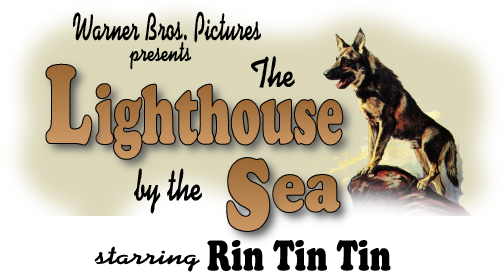

"The Lighthouse by the Sea" is a typically slick action-melodrama in the best American tradition. Based on a hack bootlegging story pepped up to provide suitable business for Rin Tin Tin and containing the usual slight romantic thread -- plus patches of revolting sentimentality -- it is lifted out of the rut by superior acting, photography, direction and staging. The interiors are nicely lit and extremely authentic in appearance. For the exteriors, the company went on locale to Laguna Beach, a port due south of Los Angeles which, incidentally, serves the film-famous Catalina Island.
Director Malcolm St. Clair was competent and versatile.
He will be remembered for "The Grand Duchess and the Waiter"
(1926) with Adolphe Menjou and Florence Vidor, and he directed
the silent film-in-a-film which was the only bright spot in the
1939 "Hollywood Cavalcade." His work was clear-cut and
concise. With judiciously chosen shots, he presented 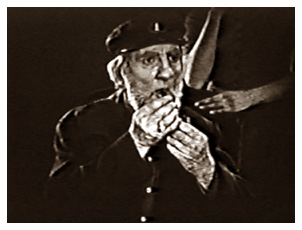 his
story in a crisp style of narrative that was made naturalistic
by careful attention to, and continuity of, characteristic gestures
and actions of his cast. One recalls films wherein the players
seemed to forget, in patches, their character idiosyncrasies,
and this is easy in film acting however competent the player as
shooting is done with no regard whatever to the time continuity
of the story. It is thus the responsibility of the director to
keep watch on this phase of the acting.
his
story in a crisp style of narrative that was made naturalistic
by careful attention to, and continuity of, characteristic gestures
and actions of his cast. One recalls films wherein the players
seemed to forget, in patches, their character idiosyncrasies,
and this is easy in film acting however competent the player as
shooting is done with no regard whatever to the time continuity
of the story. It is thus the responsibility of the director to
keep watch on this phase of the acting.
A methodical director will cover this by notes at appropriate points in the script, which will then be brought to his attention as necessary by the script girls. This is absolutely essential in a film like "The Lighthouse by the Sea" where there is continual inter-cutting of studio and location shots -- the players moving from one to the other in an instant of filmic time, but the shots being taken, perhaps, a month apart in actual time (and from Laguna Beach to Hollywood in distance).
Caleb Gale, an old, blind lighthouse keeper, lives in seclusion with his daughter Flora to avoid his affliction being discovered. Inspectors finally insist on seeing him, but he bluffs them with Flora's help. Searching for an assistant, Flora enters the saloon run by local bootlegger Joe Daggett and his associate, Crawford Sims. The latter makes up to her with a view to securing control of the light to aid their rum-running racket.
Shipwrecked nearby, Bob Dorn and his dog are found by Flora on the beach. Joe Daggett arrives and picks a fight but is driven off by the dog. And inevitably Bob is taken on as the new assistant. The bootleggers are advised by coded telegram that three hundred cases will be landed the next night. It will be essential to "fix" the light, so Crawford Sims visits Flora, and Bob watches without enthusiasm.
Joe buys a tough dog and engineers a fight with Bob's dog, who is victorious. So the thwarted Joe knocks Bob out. To avoid further trouble, Bob ties up his dog. Crawford Sims calls again. Flora hears her father approaching, tapping his stick, so she runs out and warns him. Wandering away, he is just saved from falling over the cliff by the dog who has broken loose.
That night, Bob and the dog are lured from the lighthouse, bound, and taken on to the contraband ship, "Carrie," outside the Twelve Mile Limit. Joe Daggett and Crawford Sims enter the lighthouse, knock out the old man, and extinguish the light just as the revenue cutter is using it to steer in to the bootleggers' landing dock. The "Carrie" proceeds towards the dock under cover of the darkness. Meanwhile, the dog has struggled free and freed Bob. A fight follows ending with their falling into the sea. By this time, the "Carrie" is near land. They swim ashore and race to the lighthouse, but the dog is trapped in a storeroom, and Bob, following behind, is caught and chained up. Flora comes in and is seized and taken to the "Carrie," whose cargo is being unloaded.
The dog bites his way out. He then brings matches and cotton waste to Bob who strikes a match with his feet and fires the waste which the dog then carries up, and so restores the light. Caleb recovers and releases Bob, who meets the revenue officers. With Flora's hat for scent, the dog leads them to the bootleggers' dock. The "Carrie" sets away. Bob and the dog just manage to jump aboard. The revenue cutter, guided by the restored light, intercepts the "'Carrie" while Bob knocks out Joe Daggett, and the dog downs Crawford Sims.
Caleb is retired on pension, and as the new lighthouse keeper, Bob embraces Flora on the beach, unheeding the waves. The dog looks at them with a quiet grin. On this happy scene, the film ends.
There are several points of exceptional interest in the
story, of which the above is a brief treatment. It was, of course,
specifically chosen for, and dressed to suit the star, Rin Tin
Tin. And in this connection it will be seen to provide excellent
opportunities in the way of fights with men and the other dog,
saving old Caleb's life on the cliff, saving Bob in a fight in
the sea, breaking loose from bonds, and, the most superb movement,
lighting the lighthouse lamp with burning cotton waste. In addition,
there are acting opportunities such as the affection shown to
the blind man (a nice  touch), the whimsical
look in the last shot, and the carrying back of the stake he dug
up to save Caleb.
touch), the whimsical
look in the last shot, and the carrying back of the stake he dug
up to save Caleb.
The other players lend admirable support, their characters being written up into good types. Caleb Gale is a man to be admired, and Flora embellishes her love making with jaunty eye work. The villains are hearty rather than dirty. The lighthouse itself is dramatized as an integral part of the narrative. These factors alone would ensure a well-knit film, but production value is further added by a tremendous variety of sets and locations, some of the latter being quite picturesque exteriors seen both by day and night -- and including beach scenes and sea scenes, as well as action on the revenue cutter and the "Carrie."
"The Lighthouse by the Sea" was produced when Rin Tin Tin had just reached the pinnacle of his fame. His salary was 400 pounds per week, the earning power of his film tremendous. He was found in France at the end of the last war by Lieutenant Lee Duncan of the AEF who took him back to America and trained him for the screen. And his is the distinction of being by far the most famous dog in the world. Even now, nearly ten years after his death, his name on the main title of a film provokes cheers from a boys' club audience. And the older boys of 50 upwards will shake their heads after a show and regret that "They don't make 'em like that now, boy."
Malcolm St. Clair opens his film without preamble by introducing first the lighthouse (descriptive title followed by nicely composed long shot across the bay looking towards the setting sun) and then its blind keeper and his daughter. Tension is immediately aroused by the suggested tragedy of Caleb's blindness being discovered. In a close-up, a hand raps on the door, the shadow of an official-looking profile fringing the picture. Flora opens the door. The officer and his assistant stand there, starkly white against a dead-black background. The officer parts his coat to reveal . . . C.S., the well-known badge, "U.S. Officer Int. Rev. Service." They insist on seeing Caleb Gale. It will be noted that this introduction has been very well arranged. Suspense and strong narrative interest are maintained throughout.
Flora runs ahead to warn her father. The actual meeting is superbly done in mid-shot from a low camera position which enables Caleb to dominate the frame. He firmly shakes the officer's hand but does not see that of the assistant -- who merely takes it as a small eccentricity and shrugs. Then in long shot they sit down. The set is well-arranged and exceptionally well lit, the composition being cleverly balanced by means of a spotlight down the spiral stair which makes a thin oval of light in the background, enhancing the effect of depth. Dialogue titles explain the attempt being arranged to round up the bootleggers and the vital importance of the lighthouse. Then a cigar is offered and Flora has to save the situation. "Daddy . . . always likes his old pipe best."
The officer leaves. Caleb is exhausted by the ordeal, and, as Flora goes out to seek a helper, he sits anxiously upright in his chair, his unseeing eyes staring ahead, one hand resting on the table and the other gripping the chair arm in a telling medium close-up which, had it occurred in a contemporary German film, would have had the highbrows cooing with delight. Charles Hill Mailes's make-up is admirable, in particular for the old, wrinkled hands. In contrast, one recalls the shock of seeing youthful-looking hands attached to Robert Donat towards the end of Goodbye, Mr. Chips."
We next see the legend "Jonah's Retreat" in close-up,
which mixes to a long-shot of the interior of this rather sinister
joint. In the foreground a man is being tattooed. Cut to full
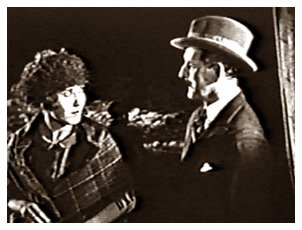 close-up of this delicate operation, showing
the artistic picture, then introductory title for Joe Daggett,
then medium close-up followed by full close-up of Joe starting
under the pricks but expressing admiration of the artistic gem
being produced. Meanwhile, in a long shot night exterior that
is really beautifully lit and shows the approach to Jonah's Retreat
with the sea rolling up to the building, Flora is eyed lustfully
by a tough sailor (as good a type as the docker in "Vaudeville")
but shrinks past and enters and is duly accosted by Joe. In response
to a whispered remark, she slaps his face. Crawford Sims, introduced
by a title, enters in time to stop the unequal struggle and sees
Flora out. He is thus rather ingeniously shown as a possible force
for good among his bootlegger confederates.
close-up of this delicate operation, showing
the artistic picture, then introductory title for Joe Daggett,
then medium close-up followed by full close-up of Joe starting
under the pricks but expressing admiration of the artistic gem
being produced. Meanwhile, in a long shot night exterior that
is really beautifully lit and shows the approach to Jonah's Retreat
with the sea rolling up to the building, Flora is eyed lustfully
by a tough sailor (as good a type as the docker in "Vaudeville")
but shrinks past and enters and is duly accosted by Joe. In response
to a whispered remark, she slaps his face. Crawford Sims, introduced
by a title, enters in time to stop the unequal struggle and sees
Flora out. He is thus rather ingeniously shown as a possible force
for good among his bootlegger confederates.
A news paragraph and superimposed pieces of driftwood indicate a wreck. Then at sunrise over an unbroken expanse of sea is shown a solitary boat with Rin Tin Tin on look-out.
TITLE: (Art background, Alsatian's head crowned with laurels
in lower R.H. corner) "For the first time since his heroic
services on the battlefields of France, the spirit of rescue surged
through the veins of a retired Red Cross Veteran . . . Rin Tin
Tin."
M.S. He looks around him . . .
C.S. . . . with thoughtful eyes . . .
Another title introduces Bob Dorn lying injured in the bottom of the boat. In close-up, very lightly fringed at the corners, Flora looks out from the lighthouse -- and in high-angle long shot, through her eyes, we see the boat hard by the rocky shore. The dog jumps overboard and swims ashore for help. The boat is capsized by a huge wave, and Bob is flung up against it. Flora drags him on to the beach. Daggett strolls up and picks his quarrel, and the dog races along to rout him. This action on the beach is photographed with the sun as back-lighting, reflectors being used to lift shadows. This was rather a mistake in the present instance, however, because though depth is thereby secured, there is considerable flare from the surface of the sea, with the result that all detail is killed in the cliff (shown with the lighthouse in the background).
Next day in at the lighthouse, Bob accepts the job in a dialogue sequence relieved by the pleasing touch of the dog's spontaneous gesture of walking up to old Caleb and laying his head on his shoulder. Flora meanders out with a tasty look over her shoulder. Bob follows. Simple but effective lighting of the medium close-up at the door gives the appearance of evening sunlight beaming in. They join by the sea in silhouetted long shot under a darkening evening sky, the camera position being chosen to convey a sense of routine romance. Slow fade-out.
C.S. (fade-in) a candle stuck in a bottle and hands playing
cards. Cigarette smoke floats across the picture. MIX TO
L.S. the players. Joe watches, and . . .
C-M.S. . . . exclaims . . .
TITLE: "I'd pay fifty bucks for a dog that knew how to scrap!"
C-M.S. he says.
L.S. From the background a figure approaches . . .
M.S. . . . him and says . . .
TITLE: "I own the 'Yukon Killer' - he's so tough I have to
feed him manhole covers for dog biscuits!"
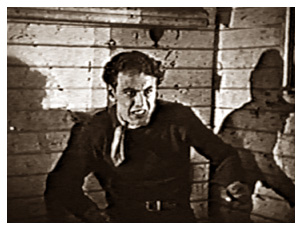 And the guy bustles away as Crawford
Sims enters with a telegram. The slick construction and cutting
of the above sequence is worth special note. Atmosphere is immediately
conveyed by the first shot. The setting is admirable (an underground
store), and slick cutting is made possible by the number of camera
positions from which the action was shot. Thus, three shots separate
the two titles where one would have covered the action but at
the expense of dramatic rhythm. The wire is in simple code of
a type used by these worthy people. The innocent message . . .
And the guy bustles away as Crawford
Sims enters with a telegram. The slick construction and cutting
of the above sequence is worth special note. Atmosphere is immediately
conveyed by the first shot. The setting is admirable (an underground
store), and slick cutting is made possible by the number of camera
positions from which the action was shot. Thus, three shots separate
the two titles where one would have covered the action but at
the expense of dramatic rhythm. The wire is in simple code of
a type used by these worthy people. The innocent message . . .
"Grandmother left for Aunt Mary's party today - will visit you tomorrow at 3 p.m. - Caroline" becomes "Ship left for New Seville today will try to land cargo tomorrow 300 cases - Cavannah"
This is done by a simple mix. The date - 26/8/1924 - is interesting. It was the almost invariable custom in such cases to put the current date.
The importance of the lighthouse is emphasized in a title, then the action shifts to Caleb teaching Bob the works while the dog watches. It is one of Rin Tin Tin's most remarkable gifts that he was able to convey understanding as in the case of a full close-up as he looks up at the burner - shot correctly from a high camera angle. Meanwhile, Crawford Sims meets Flora by the well near the lighthouse. She is not above switching a coy eye at him while Bob and the dog watch indignantly from above.
Surrounded by his gang in the village, Daggett buys the "Yukon Killer," and the fight follows -- well done in the routine way (with audience reactions) and ending with the flight of the Killer who takes refuge behind a hole in the fence through which Rin Tin Tin just cannot squeeze. Well-photographed in a shaded close-up suggesting fear, he makes to sneak away. But a turn of the head and a dirty look from the victor sends him scuttling back. Rin Tin Tin then goes to his master who has been knocked out by Daggett, and in a well-composed mid-shot, they wallow in sentimental embrace. Fade out.
The parallel actions of Bob tying up the dog and Flora inviting Sims into the cottage are intercut. Caleb approaches, the sound of his tapping stick being forcibly conveyed in a medium close-up. Flora dashes out, warns him, and clasps her hand over his mouth as he protests. Three first-class close-ups portray this action, and here the camera has been most thoughtfully used and the acting most expertly directed. Caleb wanders off . . . and then follows a routine suspense sequence as he approaches the cliff's edge. The dog sees him, strains at the stake and ultimately gets free and holds him up at the very edge of the cliff. Bob and Flora take the old man into the lighthouse, and here comes a nice touch. It dawns on Rin Tin Tin that he has broken loose without permission, so, rather sheepishly, he walks back to where he was tied, Bob following, and digs a hole and replaces the stake. The medium close-ups in which this sequence is mostly shot are exceptionally pleasant in set-up. Those of the dog are sparklingly back-lit, and those of Bob are against a diffused background of the lighthouse, the corners being fringed.
That night in Jonah's Retreat a note is surreptitiously
handed over (just in case we have forgotten about the main story!)
reading, "Put light out tonight. Will land cargo when it
goes dark." They scheme accordingly. The lighthouse shines
out - a very fine model shot. Supper over in the cottage - Caleb
and Bob go over to the lighthouse, the latter pausing to hold
Flora's hand. The villains stand, plotting, by the well. These
night exteriors, shot on location with portable equipment, are
extremely good. In the lighthouse, the dog stirs . ..
Then, -- M-C.S. (exterior) Sailor at lighthouse door - he knocks
. . .
M.S. (interior) Caleb and Bob look up . . .
C.S. (interior) The dog gets up and . . .
L.S. (interior) . . . approaches door as Bob gets up . . .
L.S. (exterior) Sailor takes a step back as dog emerges . . .
C.S. (exterior) Dog looks suspiciously at him.
The timing and balance of these shots is impeccable, and
it is interesting to note how Rin Tin Tin's sagacity is emphasised
in his instant distrust of the sailor. Bob and the dog are ambushed,
bound, and carried away. Two pin-points of light suddenly approach
the camera out of inky blackness and materialise into the car
of the revenue officers who enter the lighthouse. They tersely
inform Caleb and Flora that this is the night. The sequence is
shot from low camera angles, excellently composed and matched.
In a nicely-lit long shot, Bob and the dog are carried down a
jetty and dumped on to a rowing boat which sets out to sea. The
lighthouse shines out. Daggett and Sims see the officers leave,
and Flora goes across to the cottage. Beyond the Twelve Mile Limit,
the "Carrie" lies at anchor. In a crisp series of long
and mid-shots, we see Bob and the dog taken aboard and flung into
a cabin. The sailor is put on guard. Then . . .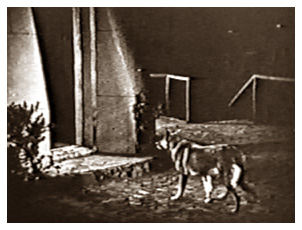
L.S. Daggett and Sims stealthily approach the lighthouse door.
L.S. Within, Caleb is reading. The door slowly opens, Daggett
advances a pace, raises pistol, aims. . .
C.S. . . . holds his aim . . .
C-M.S. Caleb reading . . .
C.S. . . . his fingers moving over embossed print . . .
So they go nearer and realise he is blind. He hears, starts,
conceals the tell-tale book, and extends his hand. Daggett grasps
it and introduces himself as sent to guard the lighthouse. The
tersely narrative conciseness of the shot construction is admirable,
as will be seen from the short excerpt above. Further suspense
follows . . .
L.S. Caleb starts up the stairs (blundering slightly into the
wall, as he cannot use his stick in the presence of strangers
- another careful directional touch).
M.S. (looking down the spiral stair) He comes wearily up, the
others following purposefully . . .
L.S. (on the second flight) He pauses . . .
C-M.S. . . . sinks down, exhausted . . .
C-M.S. The other two look at him . . .
C-M.S. . . . He remains still . . .
L.S. They climb up beside him and . . .
C-M.S. . . . push him . . .
L.S. . . . over the edge of the stair
C-M.S. Sims is shaken. They proceed upwards.
M.S. Bob lies bound in the cabin on the "Carrie."
Again, the construction merits praise. The brutal method
of disposing of old Caleb heightens the dramatic tension at a
moment when all is going too well for the villains. Then, leaving
them on their way to wreck the light, we cut immediately to Bob,
bound and helpless. The dog then bites his way out of the fishing
net in which he was bound and starts to free Bob. A complex editing
sequence follows, three concurrent actions being intercut according
to a strong suspense pattern, thus . . .
1. Dog starts biting through Bob's bonds.
2. Daggett reaches light -- light shines out.
3. Captain of revenue cutter sets course to the light.
4. Dog finishes freeing Bob.
5. Daggett succeeds in extinguishing the light.
6. Captain of the revenue cutter commands . . .
TITLE: "Order the ship stopped! We'll crash on the rocks if we try to capture them in the dark!"
At this point, the film has just over 350 16mm feet (9 and
three quarter minutes) still to run, and the narrative position
is . . .
Dagger and Sims in possession of lighthouse.
Caleb unconscious -- Flora asleep in the cottage.
Revenue cutter helpless - "Carrie" heading for shore.
Bob and dog locked in guarded cabin.
Revenue officers somewhere on shore.
It will be seen that the stage is set for some good dramatic action, at the extent of which will be seen by referring back to the brief treatment given earlier. It is the credit of the scenarist that everything is sorted out without the need for one single title, the title quoted above being the last in the film.
Expressive photographic composition emphasise the rage of the sailor and Bob's danger after his escape. The fight starts, and, just in time, the dog makes a magnificent leap through the small, high window and saves Bob, but is himself thrown overboard. The fight proceeds high up in the rigging. Finally Bob and the sailor fall into the sea, ingeniously shot in slow-motion, which emphasises the drop height and creates a grand picture as the spray spangles the strongly back-lit water surface. The dog returns to finish off the sailor. Then he and Bob swim ashore and race to the lighthouse.
For sustained technical proficiency, the remainder of the
action is remarkable. High spots are the menacing look of the
dog as he approaches the lighthouse and his leap over the table
at Crawford Sims -- Daggett's hand reaching towards the unsuspecting
Bob in sinister medium close-up -- Flora's impetuous rush to her
father -- The dog's triumphant dash up the stairs with the burning
waste and the shining out of the light once more. Then Caleb recovers
and shakily frees Bob who, with the dog leading, takes the revenue
officers to the secret 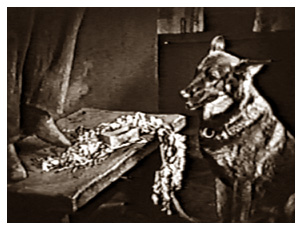 landing stage. The
bootleggers are rounded up amid their crates which have just been
unloaded. The "Carrie" sets off, the dog and Bob just
managing to leap aboard. The revenue cutter, guided by the light,
steams up and puts a shot across the bows. In a cabin, filmed
in a mid-shot packed with action, Bob knocks out Daggett, and
the dog worries Sims. Then . . .
landing stage. The
bootleggers are rounded up amid their crates which have just been
unloaded. The "Carrie" sets off, the dog and Bob just
managing to leap aboard. The revenue cutter, guided by the light,
steams up and puts a shot across the bows. In a cabin, filmed
in a mid-shot packed with action, Bob knocks out Daggett, and
the dog worries Sims. Then . . .
L.S. Officers swarm in and arrest them (and even grab Bob, but
release him as Flora explains) and . . .
M.S. . . . handcuff them.
C.S. The dog barks enthusiastically. Fade out.
C.S. Fade in (letter retiring Caleb on pension and leaving him
to appoint his successor). MIX TO
L.S. the four on the beach. The dog leads Caleb away.
M.S. Bob kisses Flora.
L.S. the same - a boisterous wave swamps them, but they don't
notice.
M..S. the dog looks at them. Slow fade out.
"The Lighthouse by the Sea" is so packed with items of technical, artistic and general interest that a brief summary is essential to record what has been omitted above. . .
Scenario
In 1924-26, Darryl Francis Zanuck did 18 scenarios for Warner
Bros., including adaptations and originals. He is now head of
20th Century-Fox. He worked on a basis of smooth action scenes
logically leading to the climax. The sidetracks had definite,
if slight, links with the main theme. Competent and not overpowering
use of hokum. Among the above 18, "Wolf's Clothing"
(Monte Blue) and "The Better 'Ole" (Syd Chaplin) will
also be remembered.
Direction
Malcolm St. Clair's straightforward style, slickness, attention
to detail, and skill in making the most of the situations called
for by the script have been indicated above. The early 1940's
find him successfully applying these methods to comedy, e.g.,
"The Big Noise" with Laurel and Hardy.
Acting
Rin Tin Tin first starred in "Where the North Begins"
(by Chester Franklin, 1923). Then came "Find Your Man"
and "The Lighthouse by the Sea." In 1925, he was generally
considered the most popular star in America. After making over
40 films, he died of old age while on location for "The Pride
of the Legion" on August 10, 1932. Several of his films are
available on 8mm and 16mm including "The Night Cry"
in which he fought and killed a gigantic South American condor
on the edge of a cliff.
William (Buster) Collier did well with the juvenile lead -- always a thankless part in a Rin Tin Tin film, as a certain weakness was essential to allow the dog to achieve logical rescues.
Louise Fazenda will be affectionately remembered in "The Pest of the Storm Country" and as the terrified maid in "The Bat," as well as many short comedies. She started in Keystones in 1917.
Charles Hill Mailes' remarkable performance deserves to rank with that of Brigitte Helm in "Jeanne Ney" and Maria Corda in "The Last Days of Pompeii" for the studied perfection of his portrayal of blindness. His make-up is also noteworthy. He was actually a middle-aged man -- remembered also for his Commodore Preble in James Cruze's 1926 production "Old Ironsides."
Mathew Betz and Douglas Gerrard were typically competent
character players from Hollywood's vast and efficient reserves.
The former was in the silent version of "The Unholy Three"
and was with William Haines in "Telling the World" (1928,
by Sam Wood). The latter was in Universal's "The Dumb Girl
of Portici" (1916, by Lois Weber and Phillips 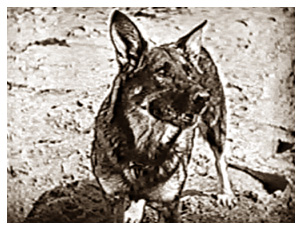 Smalley,
with Anne Pavlova).
Smalley,
with Anne Pavlova).
Photography
H. Lyman Broening's work was considerably above contemporary American
standards. The composition and lighting show considered care.
The lighthouse night exterior, for example, is a fine compositional
study. Some sea night scenes are wrong in lighting, but blue tinting
on the original lessened this ill effect. (This phenomenon was
known as Keystoning.) The available prints, being on yellow stock
throughout, emphasise it. Broening was a group leader among the
42 cameramen on the Circus Maximus set for "Ben Hur"
in November 1925. Grumbling about the projection angle at the
"Ben Hur" premiere at the Biltmore, Los Angles, he wrote
in the October 1926 American Cinematographer, "The
elongated heads and necks of our screen favourites are indeed
horrible to behold."
Design
The realism and accuracy of all sets are typical. The special
lighting and model effects are restrained and excellent.
Titles
The satisfactory convention of plain backgrounds to dialogue titles
and "art" backgrounds to continuity titles is successfully
followed. Large and wide-spaced type, and players' names stated
under their introductory titles, were Warner peculiarities.
Film Editing
Slick, in the best American tradition. In many cases several frames
were deleted in action cuts, which gives maximum compression of
time without noticeable jerkiness.
General
The chief loss in the missing 1,000 odd feet is the fight between
Rin Tin Tin and a man-eating shark. It should be noted that atmosphere
has been maintained by showing several of the bootlegger gang
in several sequences. This knits together the phases of the narrative.
Though filmed at San Pedro on the West coast, the action is supposed
to be at "New Seville" in Maine, so the experts will
enjoy pointing out that the sunset at sea must, in fact, be a
sunrise. There is also the psychological unlikeliness of Caleb
wandering to such a dangerous spot as the cliff edge! Add these
to one incorrect background (in the shots of the sailor luring
Bob from the lighthouse) and a few illiterate titles in the first
reel, and the small result is the sum total of defects in as good
an adventure-melodrama as has ever been put on the screen.